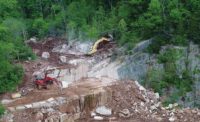Why is it important to use the original granite when remodeling or adding to old structures? Why is it important to use granite when building new structures? There is one answer to these great questions, and it can be divided into three levels: practicality, history and tradition. The one answer: modern design, historic material.
On a practical level, it matches. No other material in the world will match the current structure so perfectly. Over time, the granites, although quarried in different centuries, will come to look near exactly the same.
It will last forever and is a natural product. What could be greener than utilizing the Earth’s own product; a material that is energy efficient to harvest (we use only wire saws) and costs Mother Nature nothing. Building structures out of Mother Nature’s own material is as green as it gets. No habitats are disturbed, no harm is done.
On the historical level, historical structures were designed and built by those who came before us. Continuing their footsteps, we should carry on their legacy. History is alive. When constructing monumental structures we need to honor our past and recognize its importance.
By using the same materials from the same quarries to build modern structures, we develop our past into our present. We harmonize our nation’s timeline. With our choice comes our obligation; if we in the present do not choose to use these historic granites, those after us will not know of their importance. Like the quarries buried before them, these too will be forgotten. If the present does not preserve its history, no one after them can.
I have specialized my career in preserving these historic quarries that have built the greatest monuments and buildings of this nation. Too many quarries have been sold to developers and buried under malls and housing lots — forgotten forever; livelihoods lost. I ensure my 19 historic quarries are kept alive and well by renewing their permits, quarrying their blocks and promoting their stones.
Quarries hold a significant place in this nation’s history. Look to the small towns where these quarries are. You will see the stone everywhere, as the structural material of the church, town hall, steps, town walls, benches, graveyards and war memorials. Many of the locals will tell you how generations of their family proudly worked their whole lives as stone cutters and quarrymen. The local quarry built the towns’ economies and was the center of its citizens’ livelihood. How proud those men must have been to know those stone pieces they quarried and hand cut were headed to build the great structures of their country in all its huge metropolitan cities. Let us make those towns proud today. Our nation is one melting pot. What a grand opportunity we have before us; to use a natural recourse from a beautiful small town to build magnificent structures in our famous cities. Let your structure be a testament to our nation’s history, our national community and our national pride.
Just as within a granite piece a geologist can see a frozen history of the earth, with our monumental structures we can see our nation’s timeline, harmonized by granite. How amazing for citizens and tourists alike to come before our beautiful museum and see the same granite, quarried from the same mine, comprising designs from architects years apart, and so beautiful, so amazing, so harmonized and complete; a nod of respect for the great role granite quarrying has played in our nation’s history. And a nod of respect for tradition. We are not young fools who say “out with the old and in with the new.” Granite was used for a reason; it is strong, it is long lasting, it is natural. Look at all of the ancient Roman structures still standing. We are wise professionals who say “transform the old into the new.” Let us transpose this gorgeous natural material into our new design and show our nation we are one; from small town stone cutters to big city architects — modern design, classic material.
Stone has been building our nation since its founding. Indeed, stone has built so many world wonders, from the Egyptian pyramids to the Great Wall of China to most of Ancient Rome.
From the stunning Deer Isle quarry in Maine came the granite that graces the Empire State Building, the Pulitzer Fountain, Rockefeller Center and pretty much all of Manhattan. From the Jet Mist quarry in Virginia came the stone that comprises Time Warner AOL Headquarters, the National Airforce Memorial, the paving around the White House, the 9/11 Memorial in New York City, and so much more. From the Kershaw quarry in South Carolina came the granite that built the World War II Memorial, the Moynihan Courthouse in New York, NY, and so much more. The Milford Pink granite from Massachusetts is the granite all around the reflecting pool in front of the Lincoln Memorial, the Perry Monument in Columbus, OH, and the U.S. Post Office on 8th Ave in New York City. All of these quarries are open, running and producing stone. Should any of these, or any other older granite structure, need a match, it can be done. I am sure you have seen new work done on or near beautiful older buildings in many cities, but with a different stone, it looks unprofessional and sloppy. And while you consider designing a new structure; consider granite’s strength, beauty, eco-friendliness and history. Morphing a natural product to your design as we bring art and nature to life is true beauty and a testament to our national pride, our architectural and engineering skills, and our dedication to eco-friendly materials.
How fantastic would it be to say “this new building/park/monument is built from the same granite that creates Copley Square in Boston (Deer Isle), The Mellon Bank in Philadelphia and the Empire State Building (Deer Isle) or the Whitney Museum in New York City (Jet Mist), and the Air Force Memorial in Washington, DC (Jet Mist), 300 and 383 Madison in New York City (Midnight Grey and Deer Isle, respectively), or the Museum of Fine Arts in Boston (Deer Isle).”
|
A look at New England Stone SW: I understand why the company has invested in historic quarries, but how did your first acquisition come about? TR: I am first and foremost a stone carver. I know stone inside and out as a true artist must know his material and have hand carved much of the Christian Science Building in Boston. SW: You currently own 19 quarries and have several companies within your group. Please explain a little about each company. TR: New England Stone has done major fabrication projects and Georgia Stone is the company that operates all of the quarries. SW: What led you to start purchasing quarries? TR: As I was bidding jobs to renovate/fix/add to major buildings, parks and monuments, I was discovering that many of the original stones used were from quarries that were essentially abandoned, or not yet transitioned to an alternate use, as many historical quarries were permanently lost to the industry due to their higher monetary value as a housing development. I sought to save as many quarries as I could. SW: How much material do you produce annually? TR: Between 750,000 to 1 million cubic feet of stone total from all 19 quarries. SW: Is there a balance between producing stone for new projects and also making sure there is material reserved for historic projects, such as a building in New York City that may need stone replaced? Or is there quite a bit of surplus in your quarries? TR: There is enough stone to keep quarrying and fabricating for well over 100 years in all of our quarries. Our biggest enemy is not lack of stone; it is regulations. SW: Who primarily are your customers? TR: Ultimately, our stone ends up at major universities, such as Stanford, Harvard, Yale and George Washington University, national memorials, government buildings and courthouses and parks, libraries (federal, state, city) and Fortune 500 companies. SW: Do you have any projects that stand out as the most memorable? TR: For the National World War II Memorial, Kershaw is the main stone used. We were the fabricator and that is our quarry. We also fabricated Deer Isle for 383 Madison and Midnight Grey for 300 Madison. Also, we fabricated Oconee for the Chanel Headquarters in New York City and Jet Mist for the Capitol Visitor’s Center at the National Capitol in Washington, DC. |
|
Quarries and Locations STONE: Deer Isle LOCATION: Crotch Island, Stonington, ME STONE: Jet Mist LOCATION: Rapidan, VA STONE: Kershaw LOCATION: Heath Spring, SC STONE: Kershaw Pink LOCATION: Kershaw, SC STONE: Coral Grey/Congaree LOCATION: Heath Spring Lancaster, SC STONE: Oconee LOCATION: Greensboro, GA STONE: Sparta Pink LOCATION: Sparta, GA STONE: Midnight Grey LOCATION: Lexington, GA STONE: Dakota Mahogany/Sequoya LOCATION: Milbank, SD STONE: Texas Rose LOCATION: Llano, TX STONE: Addison Black LOCATION: Addison, ME STONE: Milford Pink LOCATION: Hopkinton, MA STONE: Madison Rose LOCATION: Madison, NH STONE: Mason LOCATION: Mason, NH STONE: Silver Cloud Imperial LOCATION: Conyers, GA STONE: Kitledge Grey LOCATION: Milford, NH STONE: Tapestry LOCATION: Milford, NH STONE: Chelmsford LOCATION: Westford, MA STONE: Royston LOCATION: Royston, GA |







